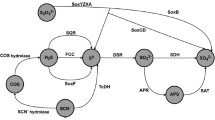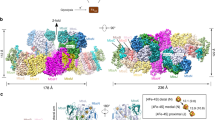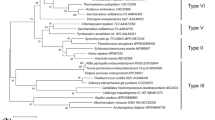Abstract
The consecutive structural genes for the iron-sulfur flavoenzyme sulfide dehydrogenase, sudB and sudA, have been identified in the genome of Pyrococcus furiosus. The translated sequences encode a heterodimeric protein with an α-subunit, SudA, of 52598 Da and a β-subunit, SudB, of 30686 Da. The α-subunit carries a FAD, a putative nucleotide binding site for NADPH, and a [2Fe-2S]2+,+ prosthetic group. The latter exhibit EPR g-values, 2.035, 1.908, 1.786, and reduction potential, E m,8=+80 mV, reminiscent of Rieske-type clusters; however, comparative sequence analysis indicates that this cluster is coordinated by a novel motif of one Asp and three Cys ligands. The motif is not only found in the genome of hyperthermophilic archaea and hyperthermophilic bacteria, but also in that of mesophilic Treponema pallidum. The β-subunit of sulfide dehydrogenase contains another FAD, another putative binding site for NADPH, a [3Fe-4S]+,0 cluster, and a [4Fe-4S]2+,+ cluster. The 3Fe cluster has an unusually high reduction potential, E m,8=+230 mV. The reduced 4Fe cluster exhibits a complex EPR signal, presumably resulting from magnetic interaction of its S=1/2 spin with the S=2 spin of the reduced 3Fe cluster. The 4Fe cluster can be reduced with deazaflavin/EDTA/light but not with sodium dithionite; however, it is readily reduced with NADPH. SudA is highly homologous to KOD1-GOGAT (or KOD1-GltA), a single-gene encoded protein in Pyrococcus kodakaraensis, which has been putatively identified as hyperthermophilic glutamate synthase. However, P. furiosus sulfide dehydrogenase does not have glutamate synthase activity. SudB is highly homologous to HydG, the γ-subunit of P. furiosus NiFe hydrogenase. The latter enzyme also has sulfide dehydrogenase activity. The P. furiosus genome contains a second set of consecutive genes, sudY and sudX, with very high homology to the sudB and sudA genes, and possibly encoding a sulfide dehydrogenase isoenzyme. Each subunit of sulfide dehydrogenase is a primary structural paradigm for a different class of iron-sulfur flavoproteins.
Similar content being viewed by others
Author information
Authors and Affiliations
Additional information
Received : 27 March 2000 / Accepted: 12 May 2000
Rights and permissions
About this article
Cite this article
Hagen, W., Silva, P., Amorim, M. et al. Novel structure and redox chemistry of the prosthetic groups of the iron-sulfur flavoprotein sulfide dehydrogenase from Pyrococcus furiosus; evidence for a [2Fe-2S] cluster with Asp(Cys)3 ligands. JBIC 5, 527–534 (2000). https://doi.org/10.1007/PL00021452
Issue Date:
DOI: https://doi.org/10.1007/PL00021452




